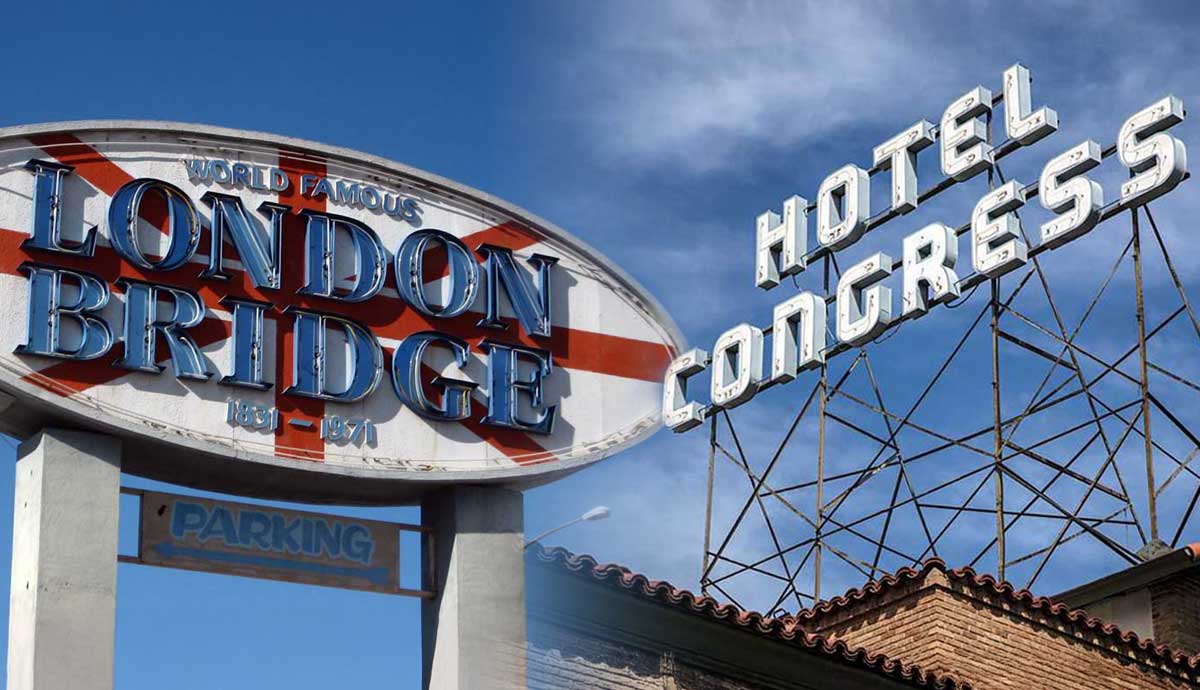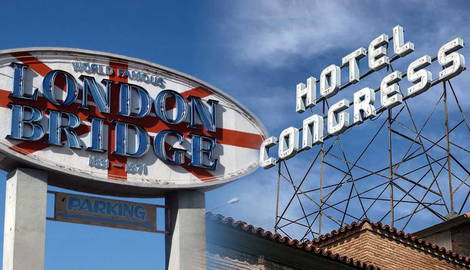
Arizona, home to Phoenix, the fifth-largest city in the United States, maybe one of the youngest states in the nation, but its history runs deep. Beyond its reputation for spring training games, vibrant universities, and record-high temperatures, Arizona offers a wealth of historical treasures. Spanning nearly 300,000 square kilometers (116,000 square miles), an area comparable to Italy, the state is filled with contrasts of climate and culture. From Southern Arizona’s rich Mexican heritage to Central Arizona’s iconic saguaro cacti and Northern Arizona’s majestic canyons and pine forests, this land is a mosaic of natural beauty and historical intrigue. Discover a state that surprises at every turn, blending both ancient and modern.
1. The London Bridge

One of the quirkiest pieces of history in Arizona is, yes, the London Bridge. But, how did this famous bridge end up in Lake Havasu City, a place known more for its water sports, spring break activities, and extremely hot summer weather?
Lake Havasu City was founded in 1963 as a planned community by Robert P. McCulloch. He envisioned Lake Havasu as a city to attract “snowbirds,” those looking for a warmer place to go for the winter. Snowbirds have long been part of the fabric of Arizona. McCulloch wanted to lure in those looking to fly south for the winter and provided a viable option for both residency and tourism. But beyond creating jobs, building housing, and meticulously planning Lake Havasu City on an impressive grid system, McCulloch was on the lookout for another way to draw attention to his project. And so he took a gamble in 1968 when he purchased the London Bridge as a marketing gimmick, and it worked.
The London Bridge, fodder for nursery rhymes, was actually “falling down” by the 1960s. Originally constructed in 1831 over the River Thames, the bridge was sinking and could no longer withstand the loads of modern traffic. By the mid-20th century, it became clear that the London Bridge needed to be replaced. In 1967 the British government decided to put up the London Bridge for sale instead of demolishing it as a way to help pay for a new bridge’s construction. This piqued the interest of McCulloch, who wanted to bring attention to his strip of barren desert land.

McCulloch purchased the London Bridge in 1968 for 2.46 million dollars. The British Government deconstructed the bridge, numbering each brick, and shipped it across the Atlantic to Lake Havasu City. The bridge was reconstructed over a recently dug canal called Bridgewater Channel and it is one of the main connectors in Lake Havasu City.
The bridge was fully reconstructed by 1971 and opened to much fanfare. McCulloch used the bridge as a marketing tactic and began advertising the opening extensively to attract tourists.
Today, the bridge serves as a unique historical talking point for not only Lake Havasu City but also Arizona. It is a testament to what a little vision and taking risks can do for a piece of land in the middle of nowhere.
2. Cathedral Rock

Located less than two hours from Phoenix, Arizona’s Sonoran Desert, filled with stately Saguaro cacti, is the gorgeous Sedona, Arizona. Driving toward Sedona is akin to transitioning from one setting of a science fiction film to another, as suddenly, out of the brown desert landscape protrude rust-colored mountain ranges set against deep blue skies.
Sedona, Arizona, a city of less than 10,000 residents, attracts over 3 million visitors each year for its unique blend of beautiful nature, hiking trails, and those seeking a sense of spiritual connection. One can’t-miss location of both spiritual and historical significance is the striking Cathedral Rock.
Cathedral Rock is a gorgeous piece of topography formed millions of years ago and is part of the Colorado Plateau. The red rocks of Sedona and Cathedral Rock get their striking red color from the presence of iron oxide in the soil. Sedona is known for its spiritual vortexes or areas of concentrated energy that people believe provide healing. Cathedral Rock is one of the most popular and has long been a historical sacred site, even though the idea of the vortexes is a relatively recent one.
The Yavapai-Apache Nation, and other surrounding tribes, have used Cathedral Rock as a site of ceremonial and ancestral rituals for thousands of years. These ceremonies include ones for healing, blessing, and burials.
After European settlers came to the region in the late 19th century, many of these sacred sites were overtaken and used as farmland. Now, these sacred sites are used in modern-day Native American rituals, with a focus on educating visitors about the sacred lands.
Cathedral Rock is now a popular hiking spot for visitors, albeit not an easy one. Many make the hike to soak up the sacred spiritual energy of the site.
3. Hotel Congress

When most people think of Arizona, they conjure up images of the Wild West. Hotel Congress in Tucson, Arizona, is one of those places where visitors can walk in today and feel like they’re walking back in time. The Hotel has stood on Congress Street in Tucson for over 100 years and is still a functioning hotel. A visit or stay here is bound to make anyone feel like they can get a little piece of Arizona history.
Hotel Congress, located in the heart of Tucson, Arizona’s downtown, has a storied history, it was originally built in 1919 as a respite for travelers on the Southern Pacific Railroad. The hotel was a grand and elegant addition to Tucson at the time.
However, it is likely most well known as the spot where notorious American gangster John Dillinger was once captured. John Dillinger was responsible for a string of bank robberies throughout the Midwest during the Great Depression. He was known for his many unique escapes from jail.
One of the times the famous gangster was apprehended was in January 1934 at Tucson’s Hotel Congress. Dillinger had been trying to lay low to avoid authorities at the time, and he chose Tucson because of its distance from where he had been committing his crimes.

One evening, the Hotel Congress caught fire, and everyone had to be evacuated. During the evacuation, someone recognized Dillinger as the face on a wanted poster, and he was subsequently arrested and extradited to Indiana.
Dillinger became J. Edgar Hoover’s Public Enemy Number One in June 1934, after escaping from the Indiana jail he had been extradited to, after his apprehension in Tucson.
Visitors can book the room Dillinger stayed in, room 214, while still enjoying the 1930s charm. The Hotel Congress has retained its original ambiance and layout, including no radios or televisions in rooms. Each year, Tucson hosts the Dillinger Days Festival with historical reenactments.
The Hotel Congress stands as a living monument to Tucson’s history. It is a fantastic landing option not only for history buffs but also for those interested in paranormal activity. The hotel has had reports of many strange occurrences in its over 100 years of existence.
Even if visitors don’t want to stay the night in a room without all the modern amenities, it is worthwhile to visit the hotel for a drink at the historic bar, or a delicious meal at the hotel’s iconic Cup Cafe.
4. The Wrigley Mansion

Along a winding road in an affluent Phoenix neighborhood, a white Mediterranean mansion sits among the desert rock formations, cacti, and skyline. A structure grand enough for Jay Gatsby to throw a party. Phoenix’s very own Wrigley Mansion.
The Wrigley family—yes of chewing gum fame—were prolific builders of homes across the United States. They had homes in Chicago, California, Wisconsin, and one in Phoenix, Arizona.
William Wrigley Jr. built the Phoenix abode starting in 1929 as a gift to his wife Ada to celebrate their 50th wedding anniversary. This luxurious home with a panoramic view of the city cost 1.2 million dollars at the time, which would be about 20 million dollars in today’s money.
The Wrigleys enjoyed Arizona as an escape from the cold Chicago winters and followed others of their affluence at the time with a home in the burgeoning Phoenix cityscape.
The home’s 24 rooms and 12 bathrooms over a sprawling 16,000-square-foot property were built to house all the modern technology of the time, including an early intercom system.

After Wrigley’s death in 1932, the mansion went through several owners. In fact, in the 1980s the home was almost fully demolished until it was deemed a historical site. In 1992, Geordie Hormel, of the Hormel food empire stepped in to save the desert beauty.
Hormel returned the mansion to its former glory and transformed it into a club and fine dining restaurant. Hormel decided to allow the public to enjoy the mansion.
One of the more unique rooms in the mansion is what is deemed “the gum room.” The small telephone booth-sized area is papered with Wrigley gum wrappers to honor the Wrigley family. The small area is now a favorite on historical tours visitors can take at the mansion.
Today, Phoenix’s Wrigley mansion has one of the best views in the city. It is still a fine dining establishment, wedding venue, and event space. It is a place to step inside to feel like a 1920s debutant even if it is only for one drink.











